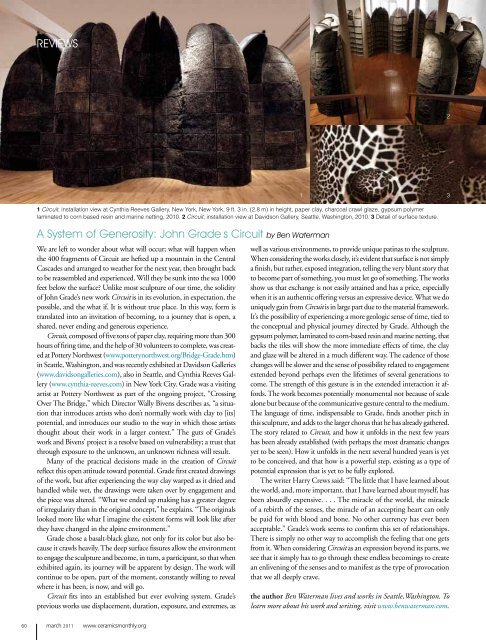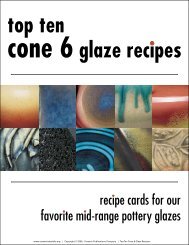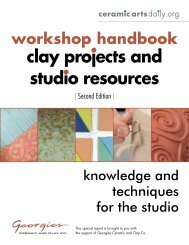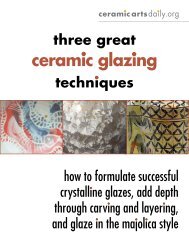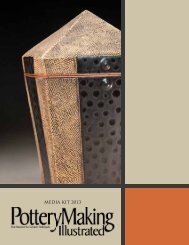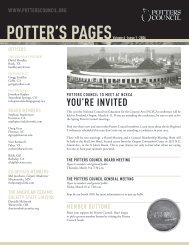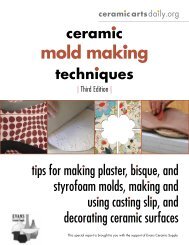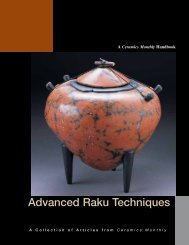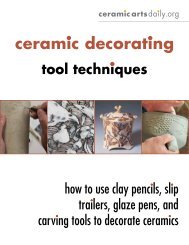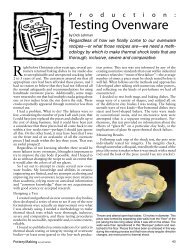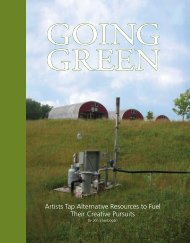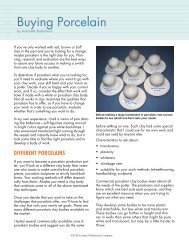Spotlight: Nick Joerling shifts gears Techno File - Ceramic Arts Daily
Spotlight: Nick Joerling shifts gears Techno File - Ceramic Arts Daily
Spotlight: Nick Joerling shifts gears Techno File - Ceramic Arts Daily
You also want an ePaper? Increase the reach of your titles
YUMPU automatically turns print PDFs into web optimized ePapers that Google loves.
EviEWs<br />
1 Circuit, installation view at Cynthia Reeves Gallery, New York, New York, 9 ft. 3 in. (2.8 m) in height, paper clay, charcoal crawl glaze, gypsum polymer<br />
laminated to corn based resin and marine netting, 2010. 2 Circuit, installation view at Davidson Gallery, Seattle, Washington, 2010. 3 Detail of surface texture.<br />
A system of Generosity: John GradeÕ s Circuit by Ben Waterman<br />
We are left to wonder about what will occur; what will happen when<br />
the 400 fragments of Circuit are hefted up a mountain in the Central<br />
Cascades and arranged to weather for the next year, then brought back<br />
to be reassembled and experienced. Will they be sunk into the sea 1000<br />
feet below the surface? Unlike most sculpture of our time, the solidity<br />
of John Grade’s new work Circuit is in its evolution, in expectation, the<br />
possible, and the what if. It is without true place. In this way, form is<br />
translated into an invitation of becoming, to a journey that is open, a<br />
shared, never ending and generous experience.<br />
Circuit, composed of five tons of paper clay, requiring more than 300<br />
hours of firing time, and the help of 30 volunteers to complete, was created<br />
at Pottery Northwest (www.potterynorthwest.org/Bridge-Grade.htm)<br />
in Seattle, Washington, and was recently exhibited at Davidson Galleries<br />
(www.davidsongalleries.com), also in Seattle, and Cynthia Reeves Gallery<br />
(www.cynthia-reeves.com) in New York City. Grade was a visiting<br />
artist at Pottery Northwest as part of the ongoing project, “Crossing<br />
Over The Bridge,” which Director Wally Bivens describes as, “a situation<br />
that introduces artists who don’t normally work with clay to [its]<br />
potential, and introduces our studio to the way in which those artists<br />
thought about their work in a larger context.” The guts of Grade’s<br />
work and Bivens’ project is a resolve based on vulnerability; a trust that<br />
through exposure to the unknown, an unknown richness will result.<br />
Many of the practical decisions made in the creation of Circuit<br />
reflect this open attitude toward potential. Grade first created drawings<br />
of the work, but after experiencing the way clay warped as it dried and<br />
handled while wet, the drawings were taken over by engagement and<br />
the piece was altered. “What we ended up making has a greater degree<br />
of irregularity than in the original concept,” he explains. “The originals<br />
looked more like what I imagine the existent forms will look like after<br />
they have changed in the alpine environment.”<br />
Grade chose a basalt-black glaze, not only for its color but also because<br />
it crawls heavily. The deep surface fissures allow the environment<br />
to engage the sculpture and become, in turn, a participant, so that when<br />
exhibited again, its journey will be apparent by design. The work will<br />
continue to be open, part of the moment, constantly willing to reveal<br />
where it has been, is now, and will go.<br />
Circuit fits into an established but ever evolving system. Grade’s<br />
previous works use displacement, duration, exposure, and extremes, as<br />
60 march 2011 www.ceramicsmonthly.org<br />
1<br />
well as various environments, to provide unique patinas to the sculpture.<br />
When considering the works closely, it’s evident that surface is not simply<br />
a finish, but rather, exposed integration, telling the very blunt story that<br />
to become part of something, you must let go of something. The works<br />
show us that exchange is not easily attained and has a price, especially<br />
when it is an authentic offering versus an expressive device. What we do<br />
uniquely gain from Circuit is in large part due to the material framework.<br />
It’s the possibility of experiencing a more geologic sense of time, tied to<br />
the conceptual and physical journey directed by Grade. Although the<br />
gypsum polymer, laminated to corn-based resin and marine netting, that<br />
backs the tiles will show the more immediate effects of time, the clay<br />
and glaze will be altered in a much different way. The cadence of those<br />
changes will be slower and the sense of possibility related to engagement<br />
extended beyond perhaps even the lifetimes of several generations to<br />
come. The strength of this gesture is in the extended interaction it affords.<br />
The work becomes potentially monumental not because of scale<br />
alone but because of the communicative gesture central to the medium.<br />
The language of time, indispensable to Grade, finds another pitch in<br />
this sculpture, and adds to the larger chorus that he has already gathered.<br />
The story related to Circuit, and how it unfolds in the next few years<br />
has been already established (with perhaps the most dramatic changes<br />
yet to be seen). How it unfolds in the next several hundred years is yet<br />
to be conceived, and that how is a powerful step, existing as a type of<br />
potential expression that is yet to be fully explored.<br />
The writer Harry Crews said: “The little that I have learned about<br />
the world, and, more important, that I have learned about myself, has<br />
been absurdly expensive. . . . The miracle of the world, the miracle<br />
of a rebirth of the senses, the miracle of an accepting heart can only<br />
be paid for with blood and bone. No other currency has ever been<br />
acceptable.” Grade’s work seems to confirm this set of relationships.<br />
There is simply no other way to accomplish the feeling that one gets<br />
from it. When considering Circuit as an expression beyond its parts, we<br />
see that it simply has to go through these endless becomings to create<br />
an enlivening of the senses and to manifest as the type of provocation<br />
that we all deeply crave.<br />
the author Ben Waterman lives and works in Seattle,Washington. To<br />
learn more about his work and writing, visit www.benwaterman.com.<br />
2<br />
3


